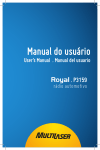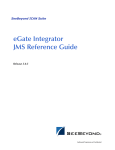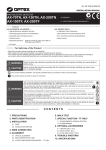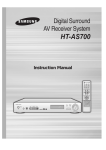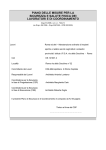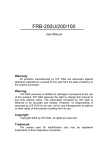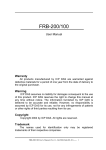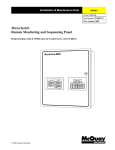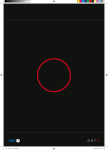Download Installation manual Emergency Telephone
Transcript
AMIGO Emergency Telephone (EN 81-28 compliant) AMIGO - ETS8128CM - ETS8128MR + ETS8128CS DMG SpA Via Quarto Negroni, 10 00040 CECCHINA (ROMA) • ITALIA Tel. +39 06930251 • Fax +39 0693025240 [email protected] • www.dmg.it Installation manual Vers. 1.2 - English NOTE: Leave this document close to the emergency telephone after installation 93010044_E_amigo_060324-0_EN.cdr AMIGO AMIGO Emergency telephone Emergency telephone SYSTEM COMPONENTS Code Description NOTES: ETS8128CM Car master device ETS8128MR Machine room device ETS8128CS Lift car slave device ETS8128SL Top/bottom of car slave device CITCOC ETS8128CH ETSGSM 2 Phone receiver Feeder / battery charger (optional) GSM Module 31 AMIGO AMIGO Emergency telephone Emergency telephone INDEX 4. Troubleshooting PROBLEM Impossible to hear the operator voice from the interphone (CITCOC) POSSIBLE CAUSE CAUSA Wrong connections Volume is set at minimum 30 SOLUTION Check connections Use the trimmer on ETS8128MR device to raise the volume 1. Product description 1.1 1.2 1.3 1.4 1.6 1.7 1.8 1.9 Technical features . . . . . . . . . . . . . . . . . . . . . . . . . . . . . . . . . . . . . . . . . . . . . . . page Main functions . . . . . . . . . . . . . . . . . . . . . . . . . . . . . . . . . . . . . . . . . . . . . . . . . . page Available signals . . . . . . . . . . . . . . . . . . . . . . . . . . . . . . . . . . . . . . . . . . . . . . . . page Basic alarm cycle setting for calls towards standard phone numbers (Without DTMFcommunication protocol) . . . . . . . . . . . . . . . . . . . . . . . . . . . . . . page Alarm cycle description for calls towards standard phone numbers (Without DTMFcommunication protocol) . . . . . . . . . . . . . . . . . . . . . . . . . . . . . . page Basic alarm cycle setting for calls towards service center . . . . . . . . . . . . . . . . . page Alarm cycle description for calls towards service center . . . . . . . . . . . . . . . . . . page External calls . . . . . . . . . . . . . . . . . . . . . . . . . . . . . . . . . . . . . . . . . . . . . . . . . . . page Operation with GSM network . . . . . . . . . . . . . . . . . . . . . . . . . . . . . . . . . . . . . . . page 2. Installation guide 2.1 2.2 2.3 2.4 2.5 2.6 "SINGLE DEVICE" configuration . . . . . . . . . . . . . . . . . . . . . . . . . . . . . . . . . . . . page "3-DEVICE" configuration (EN 81-28 norm). . . . . . . . . . . . . . . . . . . . . . . . . . . . page "4-DEVICE" configuration (EN 81-28 norm). . . . . . . . . . . . . . . . . . . . . . . . . . . . page Installation instructions . . . . . . . . . . . . . . . . . . . . . . . . . . . . . . . . . . . . . . . . . . . . page Basic connections . . . . . . . . . . . . . . . . . . . . . . . . . . . . . . . . . . . . . . . . . . . . . . . page Advanced connections (EN 81-28 norm) . . . . . . . . . . . . . . . . . . . . . . . . . . . . . . page 1.5 page 4 4 4 4 5 6 7 8 9 9 page 10 10 10 11 12 13 15 page 16 3. Programming 3.1 3.2 3.3 3.4 3.5 3.6 3.7 3.8 3.9 3.10 3.11 3.12 3.13 3.14 Function keys . . . . . . . . . . . . . . . . . . . . . . . . . . . . . . . . . . . . . . . . . . . . . . . . . . . page Navigation . . . . . . . . . . . . . . . . . . . . . . . . . . . . . . . . . . . . . . . . . . . . . . . . . . . . . page Menu map . . . . . . . . . . . . . . . . . . . . . . . . . . . . . . . . . . . . . . . . . . . . . . . . . . . . . page Stand by . . . . . . . . . . . . . . . . . . . . . . . . . . . . . . . . . . . . . . . . . . . . . . . . . . . . . . . page Numbers from 1 to 6 . . . . . . . . . . . . . . . . . . . . . . . . . . . . . . . . . . . . . . . . . . . . . page Service call number . . . . . . . . . . . . . . . . . . . . . . . . . . . . . . . . . . . . . . . . . . . . . . page Number of attempts . . . . . . . . . . . . . . . . . . . . . . . . . . . . . . . . . . . . . . . . . . . . . . page Incoming calls . . . . . . . . . . . . . . . . . . . . . . . . . . . . . . . . . . . . . . . . . . . . . . . . . . page Dialing options . . . . . . . . . . . . . . . . . . . . . . . . . . . . . . . . . . . . . . . . . . . . . . . . . . page Conversation time . . . . . . . . . . . . . . . . . . . . . . . . . . . . . . . . . . . . . . . . . . . . . . . page Voice messages . . . . . . . . . . . . . . . . . . . . . . . . . . . . . . . . . . . . . . . . . . . . . . . . . page Site identification . . . . . . . . . . . . . . . . . . . . . . . . . . . . . . . . . . . . . . . . . . . . . . . . page Type of communication protocol . . . . . . . . . . . . . . . . . . . . . . . . . . . . . . . . . . . . page Call delay . . . . . . . . . . . . . . . . . . . . . . . . . . . . . . . . . . . . . . . . . . . . . . . . . . . . . . page 4. Troubleshooting 16 16 17 18 18 19 20 21 22 23 24 26 27 28 page 30 3 AMIGO Emergency telephone AMIGO Emergency telephone 1. - Product description AMIGO is a programmable phone dialler for lifts complying with EN 81-28 norm requirements. It is available in the following versions: • Car Master device (code ETS8128CM) - see § 2.1 and 2.2 Machine room Master device (code ETS8128MR + ETS8128CS) - see § 2.3 • 1.1 - Technical features • • • • • Power supply: 12Vdc +/- 15% Absorption in stand-by: 38mA +/- 15% Absorption during the call cycle: 150mA Optional: Feeder/battery charger (code ETS8128CH) Dimensions : 90x150x20 mm Weight : 160 gr. 1.2 - Main functions • • • • • • • • • • • • • • Store capacity up to 6 phone numbers for emergency calls 1 phone number dedicated to service calls Recordable "Site identification” message Possibility of storing two customized messages associated to "Low battery charge" and "Regular operation" inputs Programmation unit with LCD screen and keyboard (16 keys) Dialler status visible on LCD display Two-way communication time programmable by the user “Low battery charge” outbound call Management of incoming system check calls Manual dialing feature to check phone line availability Interphone system between lift car and machine room (only with "Machine room" version) Local or remote alarm reset management Alarm filters management in case of working system or open doors with cage at floor Local or remote management of “wait for call status” 1.3 - Available signals • 4 "Alarm sent" - "Alarm registered" signal management 29 AMIGO AMIGO Emergency telephone Emergency telephone 3.14 - Call delay 1.4 - Basic alarm cycle setting for calls towards standard phone numbers (Without DTMFcommunication protocol) When set on “No delay”, the autodialler starts the alarm cycle immediately upon activation of the alarm pushbutton positioned on one of the alarm devices. When set on “5 sec delay”, the autodialler starts the alarm cycle only after 5 seconds of continuous activation of the alarm pushbutton positioned on one of the alarm devices (to avoid accidental calls). To set “Call delay”, press WRITE to access programming mode, then press “1” to set “5 sec delay” or “0” to set “No delay”. Press OK to store the setting (If OK is not pressed within 30 seconds, the setting is cancelled and the system goes back to Stand by). NEXT 1st number Enter in programming mode (see § 3.4) 2) Record the phone numbers to be called in case of emergency (see § 3.5) 3) Record the “Service Call” phone number where LOW BATTERY CHARGE and REGULAR OPERATION service calls must be forwarded (see § 3.6) 4) Select the desired number of alarm cycles (see § 3.7) 5) Select the type of “Incoming calls” (see § 3.8) 6) Select tones or pulses mode (see § 3.8) 7) Select conversation time (see § 3.10) 8) Make sure that the message forward option is enabled (see § 3.11) 9) Record the SITE IDENTIFICATION message (see § 3.11) 10) Record the REGULAR OPERATION message (see § 3.11) Stand by DMG Amigo XX 1) vX.X ESC OK To store 11) If the installation is provided with optional battery charger ETS8128CH (see § 2.6.2) record the LOW BATTERY CHARGE message (see § 3.11) 12) Make sure that the “No protocol” option is enabled (see § 3.13) 0 No delay 1 5 sec delay Stand by DMG Amigo XX vX.X ESC Call delay NEXT WRITE Call delay 13) Select the type of “Call delay” (see § 3.14) Notes: - If you do not want to enable the SITE IDENTIFICATION message, deselect the message forward option (see § 3.11) and disregard § 8-9 - The first phone number must be always recorded, otherwise the alarm cycle will not be triggered (5 sec delay/no delay) 1st number If no key is entered within 30 seconds, the autodialler will automatically get back to stand-by. 28 5 AMIGO AMIGO Emergency telephone Emergency telephone 1.5 - Alarm cycle description for calls towards standard phone numbers (Without DTMFcommunication protocol) 3.13 - Type of communication protocol The alarm cycle is common to all versions of the AMIGO telephone In case of emergency, if a passenger in the lift car (or other person trapped in the lift installation) pushes the alarm button of one of the alarm devices, the Emergency Telephone triggers the alarm cycle and follows this sequence: AMIGO Emergency Telephone can also dialogue with external service centers (Protocols currently implemented: ANEP, ADEMCO, SCANTRONICS). In such cases, site identification and/or status of installation data are automatically exchanged between the autodialler and the service center, therefore there is no need to voice record the service messages (Site identification, Low battery and Regular operation). 1) The Emergency Telephone connects to the phone line and dials the first stored number. 2) The "alarm sent" yellow LED switches on and after 6 seconds the "site identification " message is played three times (if recorded and if the Messages option is activated; see § 3.11). 3) If the Emergency Telephone does not receive any answer for 60 seconds, it calls the second stored number. In case of no answer, the next programmed number is called and so on. If all programmed numbers are called without reply for the programmed number of times (see § 3.7), the line is disconnected, the "alarm sent" LED stays on and the Emergency Telephone returns to the stand-by mode, ready to start a new alarm cycle. 4) After having taken the emergency call and listened to the "Site identification" message, the external operator (Call Center or other rescue service) can establish the two-way conversation by pressing the “0” key. If the operator hangs down the line or does not press the “0” key, the Telephone dials the next number. 5) When conversation time expires (this parameter can be set by the customer, see § 3.10) the Emergency Telephone sends 5 tones to the operator. If the operator presses the "*" key, conversation time is extended; if the operator presses the "#" key the telephone disconnects the telephone line, the yellow "alarm sent " LED switches off and the green "alarm received” LED switches on. The message "Wait for call" will appear on the display. 6) When the Emergency Telephone is in "Wait for call" status (duration can be set by the client, see §3.8), the external operator can connect to the site by dialing its phone number. When the communication is established, the Telephone sends 5 tones; the same tones are passed to signal that conversation time is about to end (conversation time can be extended by pressing the "* " key). When the conversation is over, the Emergency Telephone returns to “Wait for call”. 7) The "alarm received" LED can be switched off: - by pressing the "alarm off" button wired to the ALARM OFF input of the terminal board of the autodialler (if the "alarm off" input is bridged the signal switches off automatically at the end of the alarm cycle); - when a new alarm cycle is triggered; - by pressing the “*” key on the autodialler during the “Wait for call” status or during Stand-by; - by pressing the “8” from a remote phone receiver (see § 1.8). 8) The autodialler exits from “Wait for call” status and gets back to Stand-by: - after 3 minutes if “Incoming calls” is set on “OFF”; - by pressing the “*” key on the autodialler; - by pressing the “8” from a remote phone receiver (see § 1.8). Notes: - The alarm cycle is executed regardless from the availability of phone line. This is because different line signals in some countries may prevent the alarm message to be sent. - In the Quadriphony configuration (see §2.3), "alarm sent" and "alarm received" lights are placed in the Car Slave Device ETS8128CS. 6 To set the “Protocol type” press WRITE to enter the programming mode and press: - “0” to set “No protocol” - “1” to set ”ANEP” protocol - “2” to set “ADEMCO” protocol - “3” to set “SCANTRONICS” protocol then press OK to store the setting (If OK is not pressed within 30 seconds, the setting is cancelled and the system goes back to Stand by). NEXT Call delay Stand by DMG Amigo XX ESC vX.X OK To store 0 No protocol 1 Anep 2 Ademco 3 Scantronics Stand by DMG Amigo XX vX.X ESC Protocol type NEXT WRITE Protocol type (Anep/Ademco/ Scantronics/No protocol) Call delay If no key is entered within 30 seconds, the autodialler will automatically get back to stand-by. 27 AMIGO AMIGO Emergency telephone Emergency telephone 3.12 - Site identification 1.6 - Basic alarm cycle setting for calls towards service center When “Protocol Type” is set on either “ANEP” or “Ademco” or “Scantronics” (see § 3.13), the autodialler does not send voice service messages but dialogues with service centers exclusively through DTMF tones. 1) Enter in programming mode (see § 3.4) 2) Set the “1st number” with the phone number of the service center to be called in case of emergency (see § 3.5) 3) Set the “Service Calll no.” with the phone number of the service center to be called in case of emergency (see § 3.6) 4) Select the desired number of alarm cycles (see § 3.7) 5) Select the type of “Incoming calls” (see § 3.8) 6) Select tone mode (see § 3.9) 7) Select conversation time (see § 3.10) 8) Set the ID number provided by the selected service center (see § 3.12) 9) Select the type of protocol to be used to communicate with the service center (see § 3.13) In such case, an ID Number must be entered into the autodialler. The ID number will be sent to the service center and will allow the unique identification of the installation which generated the emergency call. To set the “ID Number”, press WRITE to access programming mode, then enter the site identification number (max 8 digits). Press OK to store the setting (If OK is not pressed within 30 seconds, the setting is cancelled and the system goes back to Stand by). Stand by DMG Amigo XX vX.X ESC Id number 10) Select the type of “Call delay” (see § 3.14) NEXT Id number WRITE (MAX 8 digit number) Protocol type Stand by DMG Amigo XX vX.X ESC OK To store the number NEXT Protocol type If no key is entered within 30 seconds, the autodialler will automatically get back to stand-by. 26 7 AMIGO Emergency telephone 1.7 - Alarm cycle description for calls towards service center The alarm cycle is common to all versions of the AMIGO telephone In case of emergency, if a passenger in the lift car (or other person trapped in the lift installation) pushes the alarm button of one of the alarm devices, the Emergency Telephone triggers the alarm cycle and follows this sequence: 1) The Emergency Telephone connects to the phone line and dials the first stored number. 2) The "alarm sent" yellow LED switches on. 3) If the Emergency Telephone does not receive any answer for 60 seconds, it recalls the same stored number. In case of no answer for the programmed number of times (see § 3.7), the line is disconnected, the "alarm sent" LED stays on and the Emergency Telephone returns to the standby mode, ready to start a new alarm cycle. 4) After having taken the emergency call and received the "ID number", the external operator of the service center can establish the two-way conversation. AMIGO Emergency telephone To record the “Site Identification” message, press “1”. A confirmation message (“Are you sure?”) will pop up: press “1” to start recording (”0” to stop recording), speaking close to the microphone for 20 seconds max. To record the “Low battery charge” message, press “3” and follow the same procedure. To record the “Regular operation” message, press “5” and follow the same procedure. To set “Messages”, press WRITE to access programming mode, then press “1” to set on “ON” or “0” to set on “OFF”. Press OK to store the setting (If OK is not pressed within 30 seconds, the setting is cancelled and the system goes back to Stand by). Notes: all messages are sent through if the “Protocol type” option is set on ”No Protocol” (see § 3.13). It is suggested to record a brief site identification message before both “Low battery charge” and “Regular operation” messages to help the receiver in spotting the installation. 5) When conversation time expires (this parameter can be set by the customer, see § 3.10) the Emergency Telephone sends 5 tones to the operator. If the operator presses the "*" key, conversation time is extended; if the operator presses the "#" key the telephone disconnects the telephone line, the yellow "alarm sent " LED switches off and the green "alarm received” LED switches on. The message "Wait for call" will appear on the display. 6) When the Emergency Telephone is in "Wait for call" status (duration can be set by the client, see §3.8), the external operator can connect to the site by dialing its phone number. When the communication is established, the Telephone sends 5 tones; the same tones are passed to signal that conversation time is about to end (conversation time can be extended by pressing the "* " key). When the conversation is over, the Emergency Telephone returns to “Wait for call”. 7) The "alarm received" LED can be switched off: - by pressing the "alarm off" button wired to the ALARM OFF input of the terminal board of the autodialler (if the "alarm off" input is bridged the signal switches off automatically at the end of the alarm cycle); - when a new alarm cycle is triggered; - by pressing the “*” key on the autodialler during the “Wait for call” status or during Stand-by; - by pressing the “8” from a remote phone receiver (see § 1.8). If no key is entered within 30 seconds, the autodialler will automatically get back to stand-by. 8) The autodialler exits from “Wait for call” status and gets back to Stand-by: - after 3 minutes if “Incoming calls” is set on “OFF”; - by pressing the “*” key on the autodialler; - by pressing the “8” from a remote phone receiver (see § 1.8). Notes: - The alarm cycle is executed regardless from the availability of phone line. This is because different line signals in some countries may prevent the alarm message to be sent. - In the Quadriphony configuration (see §2.3), "alarm sent" and "alarm received" lights are placed in the Car Slave Device ETS8128CS. 8 25 AMIGO AMIGO Emergency telephone Emergency telephone 3.11 - Voice messages 1.8 - External calls The autodialler manages up to three recordable voice messages (20 seconds each): AMIGO Emergency Telephone accepts calls from external phone device both during Stand-by and “Wait for call” modes. - Site Identification ( msg id tel ) - Low battery charge (msg batt.ko) - Regular operation (msg tel ok) The “Site Identification” message is sent to phone numbers stored in the memory and is passed three times at the beginning of the emergency call. To stop message reproduction and start two-way communication, the external operator must dial “0”. The “Low battery charge” message is sent to the “Service call no” phone number if the relevant input is activated (see § 2.6.2). The “Regular operation” message is sent to the “Service call no” phone number when the above input (Low battery) is deactivated (see § 2.6.2) and every 72 hours if the “Periodic test” input is activated (see § 2.6.1). If the autodialler is in the Stand-by mode and receives a call from the outside, it sends out 5 tones to signal its functioning. The external operator can switch off the “alarm received” indicator (if activated) by pressing the key “8”. If the autodialler is in the “Wait for call” mode and receives a call from the outside, it sends out 5 tones to and starts the two-way conversation with the external operator. When conversation time expires the Emergency Telephone sends 5 tones to the operator. If the operator presses the "*" key, conversation time is extended; if the operator presses the "#" key the telephone disconnects the telephone line, switches off the “alarm received” indicator (if activated) and gets back to "Wait for call" status. If “Messages” is set on “ON” all three messages are sent through. If “Messages” is set on “OFF” the “Site Identification” message is not sent through. Messages 0 1 Record "Low battery charge"message Record "Site identification” message 1 Play "Site identification” message AMIGO Emergency Telephone can use the GSM network instead of fixed line to communicate. This is made possible by connecting the car device ETS8128CM or the machine room device ETS8128MR to optional module ETSGSM. 3 Play "Low battery charge"message Messages 1.9 - Operation with GSM network 4 0 0 Messages 1 5 1 2 6 The behavior of the AMIGO with the GSM module is identical to the fixed line case. Please refer to GSM module manual for details on installation. Record "Regular operation” message Play "Regular operation” message Stand by DMG Amigo XX vX.X ESC Messages NEXT WRITE Messages (On/Off) Id number Stand by DMG Amigo XX 24 vX.X ESC 0 Off 1 On OK to store NEXT Id number 9 AMIGO AMIGO Emergency telephone Emergency telephone 2. - Installation guide 3.10 - Conversation time For first installation of the Dialler, follow the instructions below: Using this menu, users can set maximum duration of a conversation. When the conversation time has expired (between 1 and 9 minutes) the dialler sends a 3-tone signal. Then the Emergency Telephone may: • Close the conversation if no other command is given • Extend conversation time if the " *" command is given from external operator • Switch to " Wait for call" status if the "# " command is given from external operator 2.1 - "SINGLE DEVICE" configuration Call Center Operator Communication network Power supply with 12V battery code ETS8128CH (optional) To set “Conversation time”, press WRITE to access programming mode, then enter the minutes of conversation (1 to 9). Press OK to store the setting (If OK is not pressed within 30 seconds, the setting is cancelled and the system goes back to Stand by). NEXT Messages 1 2 3 4 5 6 7 8 9 10 11 12 13 14 RE SET 12V DC COM COM 72h www.dmg.it Stand by ETS8128CM AMIGO CM Car Master Device MPI Car TOP Emergency Telephone code ETS8128CM DMG Amigo XX Car BOTTOM vX.X ESC OK to store Stand by The emergency call is made by pressing the alarm button. DMG Amigo XX vX.X ESC Conv. [1-9 min.] NEXT 2.2 - "3-DEVICE" configuration (EN 81-28 norm) WRITE Conv. [1-9 min.] (Da 1 a 9) Messages Call Center operator Communication network Power supply with 12V battery code ETS8128CH (optional) If no key is entered within 30 seconds, the autodialler will automatically get back to stand-by. Bottom of Car device code ETS8128SL 1 2 3 4 5 6 7 8 9 10 11 12 13 14 RE SET 12V DC COM COM 72h www.dmg.it ETS8128CM AMIGO CM Car Master Device MPI 10 6 Top of Car device code ETS8128SL Car TOP Emergency Telephone code ETS8128CM Car BOTTOM The emergency call is made by pressing the alarm button. 23 AMIGO AMIGO Emergency telephone Emergency telephone 2.3 - "4-DEVICE" configuration (EN 81-28 norm) 3.9 - Dialing options This menu allows the user to select the dialing mode for the autodialer (DTMF tones/pulses). The choice depends on the switchboard system that supplies the line connected to the controller. Today, switchboard systems are all digital, except for a few rare cases, therefore this menu is set on “Tone” directly by the producer. To set “Dialing options”, press WRITE to access programming mode, then press “1” to set “Tone” or “0” to set “Pulse”. Press OK to store the setting (If OK is not pressed within 30 seconds, the setting is cancelled and the system goes back to Stand by). Power supply with 12V battery code ETS8128CH (optional) Interphone code CITCOC Communication network Call Center operator 1 2 3 4 5 6 7 8 9 10 11 12 13 14 RE SET 12V DC COM 72h CITCOC 2 www.dmg.it 1 6 ETS8128MR AMIGO MR Machine Room Machine Room device code ETS8128MR CAR SLAVE DEVICE SHAFT FLOOR NEXT Conv. (1-9min) Top of car device code: ETS8128SL Stand by DMG Amigo XX ESC vX.X OK to store 0 Pulse 1 Tone Car slave device code : ETS8128CS Stand by DMG Amigo XX vX.X ESC Dialing options NEXT WRITE Dialing options (Tone or Pulse) Conv. (1-9 min) The emergency call is made by pressing the alarm button. Shaft device code : ETS8128SL The emergency call is forwarded upon activation of the alarm button. If no key is entered within 30 seconds, the autodialler will automatically get back to stand-by. 22 11 AMIGO AMIGO Emergency telephone Emergency telephone 2.4 - Installation instructions 3.8 - Incoming calls The Emergency Telehone ETS8128CM and the slave device ETS8128CS can be inserted in the following plates: Questo menu permette di selezionare il comportamento del combinatore telefonico nel caso di chiamate dall’esterno durante lo statodi “Wait for call” (vedi § 1.8). A Gilda If “Incoming calls” is set on “OFF” the autodialler remains in the “Wait for call” status for three minutes, then gets back to Stand-by. If “Incoming calls” is set on “ON” the autodialler remains in the “Wait for call” status indefinitely. From “Wait for call” status it is possible to get back to Stand by (“Incoming calls” set on either “ON” or “OFF”): - by pressing “*” on the autodialler - by pressing “8” on the remote phone device (see § 1.8) From “Wait for call” status a new alarm cycle can be triggered. 100 mm To set “Incoming calls”, press WRITE to access programming mode, then press “1” to set “ON” or “0” to set “OFF”. Press OK to store the setting (If OK is not pressed within 30 seconds, the setting is cancelled and the system goes back to Stand by). B Flat plate or Gilda 103 92 200 mm 1 10 19 NEXT Dialing options ETSTPV Stand by 78 S.O.S. ETSTPO 2 S.O.S. 1 2 3 NEXT 4 5 6 WRITE 7 8 9 * 0 # ESC 73,9 132,9 R8 ESC vX.X OK OK Per confermare il dato 0 Off 1 On Stand by 30 ut Cut-o DMG Amigo XX 150 DMG Amigo XX vX.X ESC Incoming calls NEXT Space for wiring 21 WRITE Incoming calls (On o Off) Dialing options 90 3 4 5 If no key is entered within 30 seconds, the autodialler will automatically get back to stand-by. 12 8 21 AMIGO AMIGO Emergency telephone Emergency telephone 3.7 - Number of attempts 2.5 - Basic connections This menu allows the user to set how many times the saved telephone numbers need to be called before the autodialler returns to the stand-by mode. To activate the Emergency Telephone follow these instructions: 1. Do the connctions below: • Connect the Emergency Telephone to the slave devices (if present) • Connect the 12V DC power source to terminals 1(+) and 2(-) • Connect the TELEPHONE LINE to terminals 13 and 14 • Connect the ALARM PUSHBUTTON to its input • Connect the potential free contact to the ALARM OFF input (if applicable) • Connect the DMG Multiplepurpose position indicator (if applicable) 2. Connect the power supply Press the WRITE key to enter in programming mode, type in the desired number of attempts and then press OK to store the setting (If OK is not pressed within 30 seconds, the setting is cancelled and the system goes back to Stand by). During the alarm cycle, if the operator presses the "#" key at the end of the two-way communication, the alarm cycle is interrupted. 3. NEXT Incoming calls 4. Verify that the "DMG" text appears on the screen, followed by the software release number (e.g. "v.2.0") Check the phone line availability. See § 3.5 or § 3.6. Stand by DMG Amigo XX ESC vX.X OK TERMINAL BOARD LOUDSPEAKER 1 2 3 4 5 6 7 8 9 10 11 12 13 14 Stand by DMG Amigo XX ETS8128CM to store 12V DC vX.X ESC RE SET COM COM 72h LCD DISPLAY No. Attempts ETS8128MR NEXT WRITE No. Attempts (1 to 9) AMIGO ALARM RECEIVED SIGNAL 1 2 3 4 5 6 7 8 9 10 11 12 13 14 12V DC Incoming calls RE SET COM 72h CITCOC 2 1 6 KEYBOARD If no key is entered within 30 seconds, the autodialler will automatically get back to stand-by. ALARM SENT SIGNAL VOLUME LEVEL ETS8128CS 1 2 3 COM CONNECTORS MICROPHONE Terminal description (ETS8128CM / ETS8128MR) ½ 3 4 5 6 7/8 9 10 11 12 13/14 Power supply 12V DC (1 positive / 2 negative) ALARM FILTER input (if closed the telephone is disabled) ALARM OFF input (if closed all signals are reset) LOW BATTERY CHARGE input (see §2.6.2) REGULAR OPERATION input (see §2.6.1) Not used Common for inputs For ETS8128CM device: Alarm sent signal output (+12V 20mA) For ETS8128MR device: Interphone speaker For ETS8128CM device: Alarm received signal output (+12V 20mA) For ETS8128MR device: Interphone microphone For ETS8128CM device: Common for signals (-) For ETS8128MR device: Common for interphone (-) Telephone line Terminal description (ETS8128CS) 20 1 2 3 Alarm sent signal output (+12V 20mA) Alarm received signal output (+12V 20mA) Common for signals (-) 13 AMIGO AMIGO Emergency telephone RE SET COM Voice messages (in case of service calls towards standard phone numbers) or data (in case of calls towards service centers working with selected protocols, see § 3.13) relevant to service messages “Regular operation” and “Low battery charge” are sent exclusively to the phone number stored into “Service call no”. To enter/modify a phone number, scroll the menu with the NEXT key until the desired position is reached (slots from “1st number” to “6th number”), press the WRITE key, type in the phone number and then press OK to save it (If OK is not pressed within 30 seconds, the new number is cancelled and the system goes back to Stand by). The phone number contained in the chosen slot is shown on the bottom left side of the display. Press WRITE to modify it (if no number is present, the display shows “none”). When the “Service call no.” phone number is present, it is possible to: - manually connect to the phone line to check its availability. Press “1” to connect to the line and “0” to disconnect; - simulate the “Regular operation” service call. Press “2” to forward the call and “ * ” to close it. 1 2 3 4 5 6 7 8 9 10 11 12 13 14 RE SET COM 72h www.dmg.it 3.6 - Service call number COMMON INPUTS LOUDSPEAKER RECEIVER MICROPHONE RECEIVERA COMMON RECEIVER TELEPHONE LINE FEEDER 12 V DC 1 2 3 4 5 6 7 8 9 10 11 12 13 14 12V DC ALARM FILTER ALARM OFF LOW BATTERY CHARGE CYCLICAL TEST Connections for controller ETS8128MR with “4-DEVICE” configuration TELEPHONE LINE COMMON INPUTS ALARM SENT SIGNAL (+12V) ALARM RECEIVED SIGNAL(+12V) COMMON FOT SIGNALS (-) POWER SUPPLY 12 V DC ALARM FILTER ALARM OFF LOW BATTERY CHARGE CYCLICAL TEST Connections for controller ETS8128CM in “SINGLE DEVICE” and “3-DEVICE” configurations Emergency telephone 12V DC COM 72h CITCOC 2 1 6 www.dmg.it ETS8128CM ETS8128MR close the phone line (if open) MPI CAR SLAVE DEVICE Car TOP Car BOTTOM FLOOR stops the service call SHAFT Lift car top device code: ETS8128SL Lift car bottom device code: ETS8128SL CAVO 8 POLI Car alarm button (NO) CAVO 8 POLI Stand by 8 POLES CABLES INTERFACE 6 BOARDS 7 8 9 CSIT08PMS 10 1 2 3 4 5 10 POLES FLAT CABLES 1 2 3 4 5 CSIT10PMS 6 7 8 9 10 LINK WIRE TERMINALS WITH SAME NUMBER INTERFACE BOARDS CSIT08PMS DMG Amigo XX vX.X ESC 0 * 1 connects to the phone line 2 simulate the service call “Regular operation” Service call no. NEXT Service call no. WRITE (MAX di 16 digits) Next phone number Stand by 6 7 8 9 10 1 2 3 4 5 6 7 8 9 10 1 2 3 4 5 DMG Amigo XX vX.X ESC OK to store CSIT10PMS NEXT No.Attemps Only for "3-Device" configuration Car slave device code: ETS8128CS If no key is entered within 30 seconds, the autodialler will automatically get back to stand-by. MACHINE ROOM COM 1 2 3 ETS8128CS Car alarm button (NO) CS Shaft device code: ETS8128SL Car Slave Device MPI 14 AMIGO Car BOTTOM Shaft device code: ETS8128SL www.dmg.it Car TOP 8 POLES 19 AMIGO AMIGO Emergency telephone Emergency telephone 3.4 - Stand by Lift car alarm button Stand by menu appears on system startup and upon exit from programming mode. It shows the software release stored in the Emergency Telephone. Press NEXT-WRITE-OK-ESC keys and press "1 2 3 4" and then "OK" to enter programming mode. Connection symbols MPI DMG multiplepurpose position indicator/inductive ring Slave Shaft = Shaft • Floor = Main Floor Devices : Car TOP = Top of car • Car BOTTOM = Car bottom Machine Room = Machine Room autodialler Car slave device = Car slave device DMG Amigo XX 2.6 - Advanced connections (EN 81-28 norm) vX.X 3.5 - Numbers from 1 to 6 This menu enables users to store the phone numbers to be called during the alarm cycle (up to 6 numbers can be stored) . To enter/modify a phone number, scroll the menu with the NEXT key until the desired position is reached (slots from “1st number” to “6th number”), press the WRITE key, type in the phone number and then press OK to save it (If OK is not pressed within 30 seconds, the new number is cancelled and the system goes back to Stand by). The phone number contained in the chosen slot is shown on the bottom left side of the display. Press WRITE to modify it (if no number is present, the display shows “none”). The “1st number” must always be present, otherwise the alarm cycle cannot start (if no “1st number” is entered, "no tel num" will be showed in the top right side of the Stand by screen). From each slot it is possible to: - manually connect to the phone line to check its availability. Press “1” to connect to the line and “0” to disconnect; - simulate the “Regular operation” service call. Press “2” to forward the call and “ * ” to close it. Xxx number Next phone number NEXT to store 230V AC Battery charger ETS8128CH No power supply and BATTERY not charged Alim 230Vac Fusibile rete BATTERY LED OK 1 2 5 ESC 12V DC 18 vX.X No power supply and BATTERY OK Stand by Light OFF (MAX di 16 digits) Next phone number DMG Amigo XX ETS8128CH Xxx number WRITE Standard charge NEXT Slow blinking ESC NOTA: Battery Charger ETS8128CH checks battery status every 24 hours only with power supply. In case of black out the low battery output is not activated to avoid the risk that service calls further affect the battery charge. Normal blinking vX.X simulate the service call “Regular operation” 5 DMG Amigo XX 2 Fast charge Stand by * Insufficient battery charge or battery not connected 14 connects to the phone line 2.6.2 - Emergency power supply test (§ 4.1.3 in EN 81-28 norm) No alarm shall be lost even in case of power failure. If the Alarm System has a rechargeable battery, an alert message shall be sent when capacity is lower than what needed to provide 1 hour of normal operation to the system in case of power failure. To comply with this requirement, the external Battery Charger ETS8128CH (optional) must be added to AMIGO Emergency Telephone. Output n.5 of the charger must be connected to input n.5 (LOW BATTERY CHARGE) of the Emergency Telephone. When the contact is activated, AMIGO Emergency Telephone sends a service call with the “Low battery charge” message. When the contact reopens, a service call with the “Regular operation” message is sent. Light ON stops the service call 1 2.6.1 - Cyclical operating test (§ 4.2.1 in EN 81-28 norm) The Alarm System shall simulate an alarm event and establish a communication with the Rescue Service at least every 72 hours (3 days). AMIGO Emergency Telephone allows this feature through input N.6 (CYCLICAL TEST). If this input is closed (bridged), an automatic service call with the message (”Regular Operation”) is passed every 72 hours. Fast blinking 0 close the phone line (if open) Signals related to the events “car in unlocking position with cabin and landing door open” and “car running” when available from controller (or from any other device in the installation) can be used to filter undue alarms (§ 4.2.1 in EN 81-28 norm). For this purpose, connect the potential-free contact to the ALARM FILTER input of the Emergency Telephone. Full compliance to EN81-28 norm shall be achieved by connecting AMIGO Telephone to an external Rescue Service (Call Center or the like) which shall manage and record the following operating tests of the Alarm System: charger status LED Internal battery contact 5 (insufficient charge) 2 (power - 12V) 1 (power + 12V) Power supply Output Battery Autonomy “Insufficient charge” ouptut Battery test Power connections Output connections Power input protection 12v output protection 230Vac 12Vdc 300mA isolated through transformer 12V 250mAh NiMh stand-by 15H / conversation 2H open collector max 20mA every 24 hours screw terminals 2P 5mm screw terminals 3P 5mm 0,5 A 5x20mm fuse 1A fuse self repairing 15 AMIGO AMIGO Emergency telephone 3.3 - Menu map 3. - Programming Stand by see § 3.4 3.1 - Function keys Simbol Function Emergency telephone DMG Amigo XX NEXT Description NEXT Next WRITE Modify Enters menu to modify data and starts programming OK Validate ESC Exit Validates changes and starts programming Exits current menu, returns to main menu and starts programming 0 Disable When indicated in the menu, disables the relevant option 1 2 Enable Enable When indicated in the menu, enables the relevant option Simulates “Regular Operation” service call in the Xxx number menu 1 Record 2 Listen Enables recording and playback of the “Site identification” message (”Voice messages” menu) 3 Record 4 Listen 5 Record 6 Listen Menu navigation and start programming Access code vX.X OK WRITE Enter Conv. (1-9 min.) ESC ‘1 2 3 4’ NEXT Messages 1 2 Id number Site Identification see § 3.12 NEXT 4 Protocol type OK Phone Number #1 see § 3.5 Call delay see § 3.14 NEXT Phone Number #2 see § 3.5 Type of protocol see § 3.13 NEXT 1st number Call delay NEXT 2nd number NEXT Phone Number #3 see § 3.5 3.2 - Navigation Voice Messages see § 3.11 NEXT 3 Enables recording and playback of the “Low battery charge” message (”Voice messages” menu) Enables recording and playback of the “Regular operation” message (”Voice messages” menu) Conversation time see § 3.10 3th number NEXT • NEXT, WRITE, OK, ESC keys enable access to Security code menu. Once the code has been entered all menus can be navigated cyclically. • The default security code is: 1 2 3 4 • Note: The security code is not a password and its only purpose is to avoid accidental access to the system. Phone Number #4 see § 3.5 4th number NEXT Phone Number #5 see § 3.5 5th number NEXT Phone Number #6 see § 3.5 DMG v X.X NEXT Phone number for service calls see § 3.6 Number of attempts see § 3.7 No. Attempts NEXT Type 1 2 3 4 Incoming calls see § 3.8 OK Service call no. NEXT NEXT Press 6th number Incoming calls NEXT to begin programming Dialing options vedi § 3.9 Dialing options 1 Record Site identification message 2 Listen to Site identification message 3 Record Low battery charge message 4 Listen to ILow battery charge message 5 Record Regular operation message 6 Listen to Regular operation message Note: "Low battery charge" and "Regular operation" messages are sent exclusively to “Service call no” phone number NEXT 16 17
















